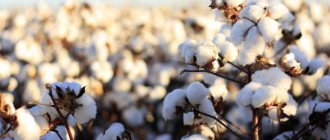The material deals exclusively with industrial varieties of hemp containing no more than 0.1% tetrahydrocannabinol (THC). Varieties of industrial hemp are included in the State Register of Breeding Achievements, permitted for use in accordance with Decree of the Government of the Russian Federation of July 20, 2007 No. 460 (as amended on October 30, 2010) “On the establishment of varieties of narcotic plants permitted for cultivation for industrial purposes, requirements for such varieties and to the conditions of their cultivation."
“We, two thirty-year-old foreheads, laid out broken seeds in an enamel basin, held a hairdryer at ear level and blew at a certain angle, and with the other hand we tossed these seeds so that the shells were blown out of them,” Andrey Kuzin describes his first entrepreneurial experience. His path to becoming a cannabis grower turned out to be thorny. Kuzin was born in the small town of Kstovo, Nizhny Novgorod region, and studied to become an accountant at Nizhny Novgorod State University. Lobachevsky and left to “look for himself” in Moscow. In the capital, he worked as a bartender and administrator in a restaurant, then got a job as a translator of technical texts. “But all this was not mine, I was not interested,” the entrepreneur recalls.
Brief information about the plant
At the beginning of the twentieth century, hemp was one of the most valuable crops on the farm. It was grown en masse on collective farms and processed in factories. It became the main source of paper and fuel production. The unpretentiousness of growing cannabis and the ease of its processing have significantly reduced the market value of finished products and made them affordable. Therefore, large oil and paper processing enterprises saw hemp as their main enemy.
In the 20th century, hemp was actively cultivated throughout the world.
In the 1940s, a whole campaign against hemp was launched in the United States, which quickly spread throughout the world. For several decades, growing cannabis seeds was banned in many countries, and research into its beneficial properties was suspended. Only at the end of the twentieth century did the technical variety of the plant begin to gain popularity on farms again.
How is hemp grown in Russia?
The problem is that the USSR ratified the 1961 UN Convention on Narcotic Drugs, which seriously complicated the rules for cultivating hemp. The Soviet state was a leader in this area, but followed the line of least resistance, reducing the area under crops as much as possible. And by the nineties, the situation had reached a critical point - in fact, it became illegal to cultivate hemp on an industrial scale. In reality, we were allowed to do this only in 2010 by a separate federal law. But in fact, people became a little bolder and began to seriously explore this market only by 2015.
— How critical was this 15-year break for the industry? And how far have other countries come during this time?
— During this time, hemp growing in Russia simply died. Of the 80 factories producing hemp (fiber based on hemp stems.— “Kommersant”
), by 2012 less than ten were still operating.
I don't want to admit that we are falling behind. But let's look at the numbers.
By 2021, 7.9 thousand hectares will be sown with hemp in Russia. And in France, where hemp cultivation has not been interrupted, 44 thousand hectares are sown with this crop, despite the fact that the country’s territory is much smaller.
True, there it is used mostly to return the land to agricultural crop rotation. Roughly speaking, with hemp the land rests, then the productivity of other crops increases. But the French still use the resulting harvest.
Fabrics, carpets, sails
Hemp fabric is durable and moisture resistant. It does not lose its properties over time and can be used for 50–60 years. In the last century, when synthetic fabrics were not common, tablecloths, bed linen, and curtains were made from cannabis fibers.
The fabric is pleasant to the touch and durable
Hemp carpets are still the most valuable and expensive. They do not tear or lose their appearance, do not get dirty easily and are easy to wash.
In the XVIII–XIX centuries. Shipping companies maintained huge hemp fields because the plant was used to make sails. At that time, only cannabis could withstand contact with salty sea water. Such sails were used for a record 10–20 years.
Clothes and shoes, bags
The first clothes made from hemp fabric were sewn in the middle of the 15th century. Shirts, dresses, jackets, sweaters keep you warm in winter and protect your body from heat in summer. The fabric does not tear, wear out or wrinkle. In addition, it is pleasant to the touch.
Hemp clothing is suitable for sports as it regulates heat exchange and prevents sweat.
Shoes made from cannabis are not yet widespread, but everyone who bought them is satisfied. Boots, shoes and sneakers are well ventilated and prevent the appearance of unpleasant odors.
Hemp backpacks are popular among young people
The most common brand remains bags and backpacks made from hemp. They are very popular among young people. Such things look stylish, do not get dirty or tear. Their service life can exceed 15–20 years.
Paper
In the mid-20th century, more paper was made from cannabis than from trees, but the anti-hemp campaign virtually destroyed production. Recently, environmentalists have often raised the issue of its resumption, as this would help stop deforestation.
From one hectare of hemp you can get no less paper than from 3-4 hectares of forest. It is stronger, better quality and easier to process. But the production of paper from cannabis would stop the work of large paper concerns. Therefore, their owners hinder solutions that would preserve the planet's environmental resources.
Building materials and paints
Building houses using waste from the production of hemp-containing products is rapidly gaining popularity in Europe and the United States. Unused cannabis is mixed with lime to create durable, heat-retaining concrete.
Building an eco-friendly hemp house
A production facility has opened in Germany, creating laminate and floor coverings from hemp cake. This product is environmentally friendly.
Hemp oil is included in construction paints. They are durable and non-toxic, but the high price prevents them from fully entering the market.
“Cannabis is also useful for aircraft manufacturing”
— What is produced from hemp in Russia now?
— The largest volumes are probably in the food sector.
- Oil?
— Not only oil can be made from hemp seeds. They make milk, yoghurts, and even cheeses with the addition of hemp mass. My personal favorite is pasta made from hemp flour under the Konoplektika brand, it is made by a Chelyabinsk company, a member of our association. I am an active consumer of them, I try to talk about them everywhere, because they are really very tasty. There are products for athletes - a high-protein mixture, popularly called protein, but this is not entirely correct, there is only a 60% protein concentration, and protein should have more.
But in hemp, Russian laboratories determine the presence of 20 amino acids, including all essential ones. This is higher than even that of soybeans.
— Do we produce dietary supplements from hemp?
- Oh, this is our headache, which is caused by legislation. In Russia, there is Technical Regulation on Food Safety No. 21, it contains Appendix 7 and line 141 - you see, I already remember it by heart. It lists substances and plants that are prohibited from being used as dietary supplements. And it says: “Hemp, all types, all parts.” Therefore, we do not have the right to produce dietary supplements from hemp, even from non-narcotic seeds.
In our country, manufacturers take regular flaxseed oil, bottle it into capsules and sell it as a dietary supplement. And hemp oil is allowed to be sold as a food product, but calling it a food additive or dietary supplement is already prohibited. So the market for dietary supplements is still closed for us.
— What else is produced from hemp in Russia, besides food?
—The traditional, historical direction is hemp fiber. We have “Mordovian hemp” - old enterprises that were engaged in this back in the golden years of domestic hemp growing. New companies are also appearing; they do not always produce high-quality fiber, but they learn from mistakes. I personally know of at least three projects where factories for the production of good hemp fiber are already under construction.
There are projects for the production of hemp pulp. The most ambitious was presented at the forum in Kurgan: Promrusskon plans to sow up to 100 thousand hectares with hemp in the Kurgan region and launch the production of biodegradable packaging. You hear about such plans with bated breath, I honestly admit to you.
— Do problems often arise with the sale of hemp products? Last year there was a big story when a Moscow pub was fined for selling imported beer with a cannabis symbol on the label. Is this a random inflection on the ground or a trend?
“Unfortunately, more and more often we come across news that the image of a cannabis leaf has been recognized as drug propaganda.
Let's think logically: I'm wearing a T-shirt made of hemp thread right now. If you embroider a cannabis icon on it, will it be propaganda for the drug? No - this is part of the material description.
If you sell beer with hemp seeds, where the leaf is depicted on the label, this is also a descriptive part to provide the buyer with complete information about the product. Yes, this is also a marketing ploy, but if there really is hemp, then it is absolutely legal.
Biofuel and mulch
Hemp also competes with oil production. Environmentally friendly raw materials are part of safe and cheap fuel. Due to the fact that heavy industry may suffer large losses, the heads of oil refining companies are preventing the development of gasoline production from cannabis.
But recently this plant is increasingly grown as a fertilizer. It is used as mulch. The stems and leaves of the plant are dried and used to cover the soil near the roots. This protects garden crops from frost, drying out and the appearance of weeds, and also saturates the soil with useful substances.
Hemp mulch protects the soil from drying out
What business problems are legal cannabis suppliers facing and how much are they making?
I would like you to describe this point in detail - such information may be useful to entrepreneurs. The FAS and I discussed this problem in detail. They say that such accusations of drug propaganda are an abuse of police powers, “obstructing a business entity from carrying out its activities,” to use official language. Therefore, if you have a similar situation, contact the FAS at the pre-trial stage. As a rule, this helps to end the case. And if a trial has already begun, be sure to ask to involve FAS experts as third parties so that they can conduct their research and make a determination.
But this is only true in cases where the hemp leaf can be considered a characteristic of the product. And when the owner of a Zhiguli was recently fined for a sticker with a hemp leaf - excuse me, there are no hemp materials in the Zhiguli. This is not a BMW.
— Is there cannabis in BMW?
— At one time, Henry Ford tried to use hemp-based composite materials in the automotive industry. It didn’t get developed back then—it was a bit expensive. But now the situation is different. Don’t forget that hemp is a particularly durable material; it retains odors, temperature, and insulates sound well. And Western automobile concerns - not just BMW - use hemp-based composite materials. For example, they make door gaskets and some parts from them. By the way, hemp composites are used in the skin of Boeings, so cannabis is also useful for aircraft construction.
At the Timiryazev Academy they showed me several samples of various hemp materials. At first I thought they were sheets of some kind of metal. I knock on them and they ring like iron. Only when I picked it up did I find out that they were too light.
You know, as we say, if you have hemp, you can survive anywhere.
These include food, medicine, clothing, and construction materials. You can build a car from hemp and fill it with fuel from hemp. ( Laughs
.) But seriously, we have companies in our association that have already received the first samples of hemp biodiesel of fairly high quality. The same “Promrusskon” plans to use part of the harvest for biodiesel - to fuel its hemp harvesting equipment. The result is completely waste-free production.
Butter, milk, flour, tofu, chocolate
Previously, hemp oil was used in the same way as sunflower oil. It has a pleasant taste and rich aroma, as well as medicinal properties. The oil contains vitamins, amino acids and proteins. It can be added to salads, sauces and dressings to saturate the body with useful substances during the cold season.
Cannabis milk is a healthy and expensive drink. It is included in nutritional shakes and smoothies. To obtain it, the seeds are soaked and ground, then the resulting liquid is cooled and infused. Milk contains vitamins, beneficial acids and microelements, and has a calming and analgesic effect. The drink is made from an industrial type of plant, so there is no narcotic substance.
Hemp flour is most often mixed with other flours and added to baked goods to produce a pleasant nutty flavor. It also contains a large number of useful substances. Products with such flour can be consumed by people with gluten intolerance.
Tofu cheese with cannabis is a real delicacy. In restaurants it is served with green beans and soy sauce. This dish is considered healthy and natural.
Chocolate containing this plant is becoming increasingly common in Europe. Ground seeds are added to the classic recipe, which makes the product healthier and adds new notes of taste.
Chocolate
Tofu
Flour
Milk
Oil
“We really need a dialogue with the Ministry of Internal Affairs”
— You mentioned hemp medicines. Is the medical use of cannabis real in modern Russia?
— We are conducting a dialogue with the relevant committee of the State Duma, with the Ministry of Industry and Trade, with the Ministry of Health of Russia - I am part of the working group on painkillers. And we said there that cannabis will not completely replace opiates, but it can help many patients. To put it very roughly, drugs of the opium group block pain receptors - it seems to be there, but it does not reach consciousness. And cannabinoids relieve spasticity and relax. For really severe pain, cannabis will not help, but it can relieve quite a lot.
— Are we talking about THC?
— No, about cannabidiol (CBD). This is another cannabinoid found in the plant, but it is not harsh or psychoactive. In Russia it still has an ambiguous legal status. They and THC are almost opposite in their effects on the body: if the psychotropic substance gives an stimulating effect, hypertonicity, then CBD relaxes and calms. I usually explain the difference this way: imagine that your home is a mess. You can do something radical - throw all your things on the floor, empty the contents of the cabinets and then start laying them out again. Or you can just carefully rearrange things and put everything in its place step by step. Here THC is the first option, and CBD is the second. It is absolutely legal in many countries, and now there is a CBD boom in the world. It is added to foods, medications, various ointments, capsules, cosmetics, dietary supplements... The so-called CBD oil is very popular - vegetable oil with the addition of 5% to 15% CBD.
Of course, Russian hemp growers are very interested in this direction. Moreover, we have a certain advantage: in domestic industrial varieties there is very little THC, and much more CBD. There is no need to purchase expensive equipment to separate them. But I never tire of warning my colleagues: “Let’s wait. “I understand that everyone wants to enter this market, but let’s wait for clear legislative regulation of hemp products.”
- How long to wait?
— At the beginning of January, a bill was introduced to the State Duma allowing the cultivation of narcotic plants for the production of medical drugs. The explanatory note states that its essence is import substitution. Opium group drugs in Russia are completely imported, because we cannot grow opium poppy. And these are drugs for anesthesia, for pain relief - vital things. And we are talking about a state monopoly on the cultivation and processing of poppy, when the fields will be protected by the Russian Guard, and then the harvest will be used for medical drugs.
The problem is that the law simply says “narcotic plant.” And the list of such plants permitted for cultivation for industrial purposes has already been established by the government, and now only hemp is indicated in it.
And there is a danger that medical cannabis products will become the subject of a state monopoly. It is clear that then you can immediately forget about competition, product diversity, and quality improvement.
Another risk is that the bill simply refers to “narcotic plants cultivated for industrial use.” It may well turn out that farmers will eventually be required to enter into contracts with the Russian National Guard to protect fields of industrial hemp, even if it contains an insignificant 0.1% THC. It is clear that the departments want to make money, but we would like to restore the industry.
We are now communicating with deputies and ask them to take into account all these nuances. The bill has already passed its first reading; We hope that by the second our position on the medical use of industrial hemp will be heard. Let it be licensing, let it be difficult to obtain this license, but if private business is allowed to do this, we will get our domestic hemp preparations. However, it must be taken into account that various preclinical and clinical trials take at least five years.
On the other hand, we really hope that the adoption of this law will force other departments to reconsider their regulations. I mean first of all the Ministry of Internal Affairs. In their official documents they use “hemp” and “cannabis”, and even slang words: “marijuana”, “anasha”, “hashish”. But nowhere is there a definition on what basis a substance belongs to one or another prohibited group. What is the difference between anasha and hashish?
- Well, I can roughly imagine...
“But I have no idea, although I am deeply immersed in the affairs of the hemp industry. There is no legal definition. Can you tell the difference between cannabis resin and hashish oil?
- No.
- And I don’t know. I understand that the Ministry of Internal Affairs considers all these substances to be narcotic because they contain THC. Well, write it like this, why use slang in documents. But we do not have the practice of prescribing the percentage of psychoactive substances in regulations.
We really need a dialogue with the Ministry of Internal Affairs. Not in order to somehow bend them, but to decide in which paradigm we can act. So that the market develops and there are no drugs.
— Is this dialogue ongoing now?
- Unfortunately no. I invite the Ministry of Internal Affairs to all our events, to closed working meetings, but I only receive formal replies.




